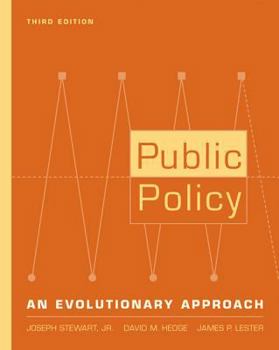Public Policy: An Evolutionary Approach
Select Format
Select Condition 
Book Overview
A unique historical perspective emphasizes the evolution of public policy analysis while discussing how policy is currently formulated. This description may be from another edition of this product.
Format:Paperback
Language:English
ISBN:0534574947
ISBN13:9780534574949
Release Date:August 2007
Publisher:Cengage Learning
Length:256 Pages
Weight:1.30 lbs.
Dimensions:0.6" x 7.4" x 9.2"
Customer Reviews
2 ratings
Good textbook on public policy
Published by Thriftbooks.com User , 15 years ago
I have used this as a textbook in some graduate courses that (I have taught on public policy and policy analysis). It has been received well by students; in addition, outside of a few quirks, I also think highly of this volume as a textbook. What is public policy? The authors note that it is government action aimed to remedy some public problem (whether real or imagined). The book is structured simply. The first part provides background, including chapters on the nature of public policy, the evolution of public policy and policy studies, approaches to policy analysis, and various models of policy. This segment of the book mainly provides context for what follows. Part two focuses on the so-called stages of the policy process--agenda setting (what gets defined as a problem; does the problem receive enough attention to begin to get discussed in government circles); policy formulation (once an issue gets on the agenda, what goes into development of a policy proposal?); policy implementation (once a law is passed or some other decision made, how does it get put into action); policy evaluation (does the policy answer the problem? What effects does the policy decision have?); [policy change and termination (what is the nature of policy change? Why and how do some policies get terminated?). There are some quirks here. Under policy change, there are some models that are simply unsatisfying (e.g., zigzag models). Part 3 looks at specific policy areas--from education to welfare to crime to the environment. My reading is that the authors play it pretty straight. Under welfare policy, they note both liberal and conservative critiques (in fact, I wish they went beyond this simple two-dimensional analysis). The final part of the book looks at how policy knowledge does (or does not) get used in decision making. There is also a final examination of the evolution of policy studies over time. All in all, a pretty good introduction to the policy process.
Beneficial to Any Policy Analysis Understanding
Published by Thriftbooks.com User , 17 years ago
Public Policy: An Evolutionary Approach provides straight-forward history on the evolution of undesrtanding of public policies to the evolution of approaches and models. I do not detect any bias in the material in the first two segments of the book. I did not spend sufficient time with part three describing the analytical approaches outlined to the case studies to weigh any idealogical bias. Nonetheless, for any policy analyist, this is an important academic book for political science and public policy. Any person involved in seeking to influence policy, engaged in policymaking, or implementation of policy, this book, in my judgment, is a required reading.






